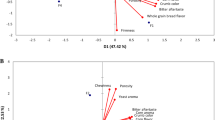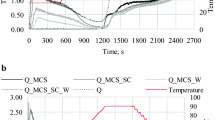Abstract
Rice and corn flour/starch are frequently used in the manufacture of gluten-free products, which are usually characterized by high starch content, low fiber content, poor texture, insufficient volume, short shelf life, fast staling, and easy crumbling. The objective of this study was to use amaranth, quinoa, and chia flours, separately or in combination, and corn starch in different ratios as an alternative to wheat/rice flours. Furthermore, several hydrocolloids (methylcellulose, carboxymethylcellulose, xanthan gum, and guar gum) were added at different levels (2, 3, and 4%) to the precited flours in order to improve the technological properties of gluten-free bread, enhance its nutritive value, and avoid the negative effects caused by the ingestion of gluten for coeliacs. The increase in pseudocereal flours’ ratios produced dark dough and resulted in a decrease in specific volume and an increase in moisture content and crumb texture hardness in all bread formulations (except in quinoa breads). The increase in hydrocolloids’ levels contributed to an increase in the moisture content, specific volume, L values of crumb color, and hardness of all breads. The formulations prepared with the lowest ratio of pseudocereal flours (10%) at the highest hydrocolloid concentration (4%) produced better quality bread than the control in terms of acceptability. Among the pseudocereal-containing breads, quinoa breads had the best specific volume and crumb hardness, followed by chia, mixture, and amaranth breads. The formulations containing natural hydrocolloids combined with amaranth, quinoa, and chia flours could be interesting to produce “better-quality and healthier” bread for coeliacs.
Graphical abstract







Similar content being viewed by others
Availability of data and material
The datasets used and/or analyzed during the current study are available from the corresponding author (AA) on reasonable request.
Code availability
Not applicable.
Abbreviations
- CD:
-
Celiac disease
- CP:
-
Celiac patients
- GF:
-
Gluten-free
- MC:
-
Methylcellulose
- CMC:
-
Carboxymethylcellulose
- SSL:
-
Sodium stearoyl lactylate
- GFC:
-
Gluten-free control
- A:
-
Amaranth
- Q:
-
Quinoa
- C:
-
Chia
- M:
-
Mixture
- TPA:
-
Texture profile analysis
References
AACC (2010) Approved methods of American association of cereal chemists, 11th edn. Cereals & Grains Association, St.Paul
Alvarez-Jubete L, Arendt EK, Gallagher E (2009a) Nutritive value and chemical composition of pseudocereals as gluten-free ingredients. Int J Food Sci Nutr 60(S4):240–257. https://doi.org/10.1080/09637480902950597
Alvarez-Jubete L, Auty M, Arendt EK, Gallagher E (2009b) Baking properties and microstructure of pseudocereal flours in gluten-free bread formulations. Eur Food Res Technol 230(3):437–445. https://doi.org/10.1007/s00217-009-1184-z
Barker JM, Liu E (2008) Celiac disease: Pathophysiology, clinical manifestations, and associated autoimmune conditions. Adv Pediatr 55(1):349–365. https://doi.org/10.1016/j.yapd.2008.07.001
Bodroža-Solarov M, Filipčev B, Kevrešan Ž, Mandić A, Šimurina O (2008) Quality of bread supplemented with popped amaranthus cruentus grain. J Food Process Eng 31(5):602–618. https://doi.org/10.1111/j.1745-4530.2007.00177.x
Culetu A, Susman IE, Duta DE, Belc N (2021) Nutritional and functional properties of gluten-free flours. Appl Sci 11(14):6283. https://doi.org/10.3390/app11146283
Demirkesen I, Mert B, Sumnu G, Sahin S (2010) Rheological properties of gluten-free bread formulations. J Food Eng 96(2):295–303. https://doi.org/10.1016/j.jfoodeng.2009.08.004
Dizlek H, Awika JM (2023) Determination of basic criteria that influence the functionality of gluten protein fractions and gluten complex on roll bread characteristics. Food Chem (part b) 404:134648. https://doi.org/10.1016/j.foodchem.2022.134648
Dizlek H, Özer MS (2016) The impacts of various ratios of different hydrocolloids and surfactants on quality characteristics of corn starch based gluten-free bread. Cereal Res Commun 44(2):298–308. https://doi.org/10.1556/0806.43.2015.049
Drub TF, Garcia dos Santos F, Ladeia Solera Centeno AC, Capriles VD (2021) Sorghum, millet and pseudocereals as ingredients for gluten-free whole-grain yeast rolls. Int J Gastron Food Sci 23:100293. https://doi.org/10.1016/j.ijgfs.2020.100293
Gómez M, Ronda F, Blanco CA, Caballero PA, Apesteguía A (2003) Effect of dietary fibre on dough rheology and bread quality. Eur Food Res Technol 216(1):51–56. https://doi.org/10.1007/s00217-002-0632-9
Green PHR, Cellier C (2007) Celiac disease. New Engl J Med 357(17):1731–1743. https://doi.org/10.1056/NEJMra071600
Guarda A, Rosell CM, Benedito C, Galotto MJ (2004) Different hydrocolloids as bread improvers and antistaling agents. Food Hydrocoll 18(2):241–247. https://doi.org/10.1016/S0268-005X(03)00080-8
Houben A, Höchstötter A, Becker T (2012) Possibilities to increase the quality in gluten-free bread production: an overview. Eur Food Res Technol 235(2):195–208. https://doi.org/10.1007/s00217-012-1720-0
Kohajdová Z, Karovičová J (2009) Application of hydrocolloids as baking improvers. Chem Pap 63(1):26–38. https://doi.org/10.2478/s11696-008-0085-0
Lazaridou A, Duta D, Papageorgiou M, Belc N, Biliaderis CG (2007) Effects of hydrocolloids on dough rheology and bread quality parameters in gluten-free formulations. J Food Eng 79(3):1033–1047. https://doi.org/10.1016/j.jfoodeng.2006.03.032
Mariotti M, Lucisano M, Ambrogina Pagani M, Ng PKW (2009) The role of corn starch, amaranth flour, pea isolate, and psyllium flour on the rheological properties and the ultrastructure of gluten-free doughs. Food Res Int 42(8):963–975. https://doi.org/10.1016/j.foodres.2009.04.017
Mccarthy DF, Gallagher E, Gormley TR, Schober TJ, Arendt EK (2005) Application of response surface methodology in the development of gluten-free bread. Cereal Chem 82(5):609–615. https://doi.org/10.1094/CC-82-0609
Mezaize S, Chevallier S, Le Bail A, de Lamballerie M (2009) Optimization of gluten-free formulations for french-style breads. J Food Sci 74(3):E140-146. https://doi.org/10.1111/j.1750-3841.2009.01096.x
Mohammadi M, Sadeghnia N, Azizi MH, Neyestani TR, Mortazavian AM (2014) Development of gluten-free flat bread using hydrocolloids: Xanthan and CMC. J Ind Eng Chem 20(4):1812–1818. https://doi.org/10.1016/j.jiec.2013.08.035
Ozturk OK, Mert B (2018) The use of microfluidization for the production of xanthan and citrus fiber-based gluten-free corn breads. LWT Food Sci Technol 96:34–41. https://doi.org/10.1016/j.lwt.2018.05.025
Rosell CM, Rojas JA, de Barber CB (2001) Influence of hydrocolloids on dough rheology and bread quality. Food Hydrocoll 15(1):75–81. https://doi.org/10.1016/S0268-005X(00)00054-0
Sanz-Penella JM, Wronkowska M, Soral-Smietana M, Haros M (2013) Effect of whole amaranth flour on bread properties and nutritive value. LWT Food Sci Technol 50(2):679–685. https://doi.org/10.1016/j.lwt.2012.07.031
Sapone A, Bai JC, Ciacci C, Dolinsek J, Green PH, Hadjivassiliou M, Kaukinen K, Rostami K, Sanders DS, Schumann M, Ullrich R, Villalta D, Volta U, Catassi C, Fasano A (2012) Spectrum of gluten-related disorders: consensus on new nomenclature and classification. BMC Med 10(1):1–13. https://doi.org/10.1186/1741-7015-10-13
Schober TJ, Messerschmidt M, Bean SR, Park SH, Arendt EK (2005) Gluten-free bread from sorghum: quality differences among hybrids. Cereal Chem 82(4):394–404. https://doi.org/10.1094/CC-82-0394
Schoenlechner R, Drausinger J, Ottenschlaeger V, Jurackova K, Berghofer E (2010) Functional properties of gluten-free pasta produced from amaranth, quinoa and buckwheat. Plant Food Hum Nutr 65(4):339–349. https://doi.org/10.1007/s11130-010-0194-0
Sciarini LS, Ribotta PD, León AE, Pérez GT (2010) Effect of hydrocolloids on gluten-free batter properties and bread quality. Int J Food Sci Tech 45(11):2306–2312. https://doi.org/10.1111/j.1365-2621.2010.02407.x
Škara N, Novotni D, Čukelj N, Smerdel B, Ćurić D (2013) Combined effects of inulin, pectin and guar gum on the quality and stability of partially baked frozen bread. Food Hydrocoll 30:428–436. https://doi.org/10.1016/j.foodhyd.2012.06.005
Skendi A, Mouselemidou P, Papageorgiou M, Papastergiadis E (2018) Effect of acorn meal-water combinations on technological properties and fine structure of gluten-free bread. Food Chem 253:119–126. https://doi.org/10.1016/j.foodchem.2018.01.144
Steffolani E, Hera E, Pérez G, Gómez M (2014) Effect of chia (Salvia Hispanica L.) addition on the quality of gluten-free bread. J Food Quality 37(5):309–317. https://doi.org/10.1111/jfq.12098
Acknowledgements
The authors would like to deeply acknowledge the volunteers who participated in this work, Scientific Research Projects Unit of Çukurova University, and the food companies for supplying the materials used in the study.
Funding
This work was supported by the Scientific Research Projects Unit of Çukurova University [grant number FBA-2017–8926].
Author information
Authors and Affiliations
Contributions
AA: Conceptualization, data curation, formal analysis, investigation, methodology, validation, visualization, writing—original draft. HD: data curation, methodology, validation, visualization, writing—original draft, writing—review and editing. MSÖ: conceptualization, funding acquisition, methodology, project administration, resources, validation, supervision.
Corresponding authors
Ethics declarations
Conflict of interest
The authors declare that they have no conflict of interest.
Ethics approval
Approval was obtained from the ethics committee of Çukurova University (Turkey). The procedures used in this study adhere to the tenets of the Declaration of Helsinki.
Consent to participate
Informed consent was obtained from all individual participants to sensory panel included in the study.
Consent for publication
The authors affirm that human research participants provided informed consent for publication of the data in Table 4.
Additional information
Publisher's Note
Springer Nature remains neutral with regard to jurisdictional claims in published maps and institutional affiliations.
Supplementary Information
Below is the link to the electronic supplementary material.
Rights and permissions
Springer Nature or its licensor (e.g. a society or other partner) holds exclusive rights to this article under a publishing agreement with the author(s) or other rightsholder(s); author self-archiving of the accepted manuscript version of this article is solely governed by the terms of such publishing agreement and applicable law.
About this article
Cite this article
Alsaiqali, A., Dizlek, H. & Özer, M.S. Effects of separated and combined amaranth, quinoa and chia flours on the characteristics of gluten-free bread with different concentrations of hydrocolloids. Chem. Pap. 77, 5275–5291 (2023). https://doi.org/10.1007/s11696-023-02861-w
Received:
Accepted:
Published:
Issue Date:
DOI: https://doi.org/10.1007/s11696-023-02861-w




